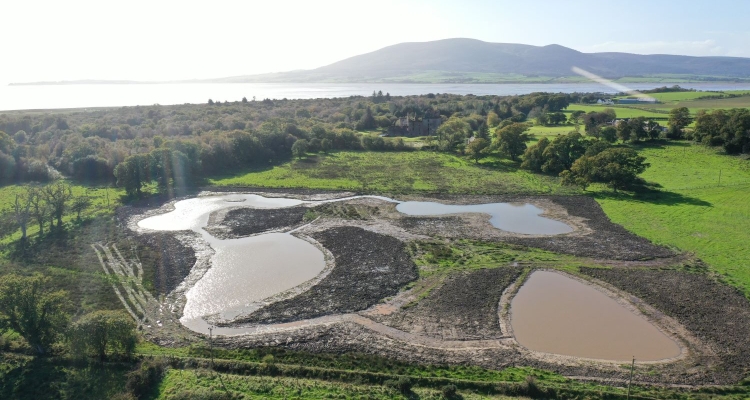Restoring Nature's Balance: Link Caerlaverock

A network of wetlands, wildlife corridors and meadows
In the heart of the Solway Coast, in South West Scotland, a transformation is taking place. Link Caerlaverock aims to create an interconnected network of wetlands, wildlife corridors, and meadows that will protect and restore the area’s unique biodiversity and ecosystems for generations to come.
A Landscape Rich in History and Biodiversity
Caerlaverock Estate, nestled along the picturesque Solway Firth, has long been a haven for wildlife. Its unique position, bordering the Solway Special Protection Area (SPA) and the Ramsar Upper Solway Flats and Marshes site, makes it a crucial piece in the puzzle of coastal conservation.
The Solway Coast, with its unique blend of saltmarshes and wetlands, is a biodiversity hotspot facing significant challenges from climate change and human activities. Enter ‘Link Caerlaverock’, an ambitious project aimed at creating, restoring, and connecting vital habitats across this spectacular landscape in Dumfries and Galloway, Scotland.
Caerlaverock Estate is embarking on a transformative journey to enhance and protect the area’s rich biodiversity. The project envisions a connected landscape where wildlife can thrive, creating wetlands, wildlife corridors, and meadows across the coastal location. By linking with work done by neighbouring partners such as the Wildfowl & Wetlands Trust (WWT) and NatureScot, the project provides crucial inland buffer support to these areas.
Wetland Restoration: A Haven for Waders and Wildfowl
A primary focus of ‘Link Caerlaverock’ is wetland restoration. These vital habitats will increase suitable areas for waders, wildfowl, and associated species of plants and invertebrates. The project plans to create multiple wetland sites, totalling approximately 15,000 square metres, beside the salt marsh (Site of Special Scientific Interest or SSSI). These wetlands will link the National Nature Reserve (NNR) and WWT inner wetland corridor, creating a mosaic of interconnected habitats.
Most wader and wildfowl species on the Solway Special Protection Area (SPA) and Ramsar site are Red or Amber listed, indicating their vulnerable conservation status. By creating these wetlands, ‘Link Caerlaverock’ will provide further functionally-linked-land for such species to feed and roost.
Planning for the Future: Natterjack Toads and Tadpole Shrimps
Climate change is leading to rising sea levels, posing a significant threat to coastal habitats. ‘Link Caerlaverock’ is taking a proactive approach by planning for the future habitats of endangered species such as natterjack toads and tadpole shrimps.
The project will create wetland areas behind the merse (saltmarsh), ensuring there are many options for these species to migrate to as coastal squeeze moves them further inland. Specifically, the project will create ponds totalling approximately 11,500 square metres adjacent to the SSSI/NNR.
Wildlife Corridors and Meadows: Connecting and Diversifying Habitats
Creating wildlife corridors is another crucial aspect of ‘Link Caerlaverock’. These corridors will allow resident species safe passage from the NNR and SSSI to existing woodlands and planned areas of conservation. The project plans to create approximately 2,600 metres of double-planted berry-rich native shrubs and trees.
The creation of wildflower meadows is another key component, increasing habitat for pollinators. The project aims to create meadow habitats totalling approximately 51,000 square metres over five sites. Equipment will be acquired for managing a native meadow seed nursery, allowing for the harvest of hay which can then be used to grow additional meadows.
Woodland Enhancement and Merse Management
‘Link Caerlaverock’ also recognises the importance of woodland habitats. The project plans to plant approximately 800 native trees in small copses adjacent to wetland sites, providing further habitat for the endangered willow tit and other declining bird species.
The merse, or saltmarsh, will be managed using a herd of approximately 40 Belted Galloway cows. To overcome the challenges of fencing in a tidal environment, the project will employ GPS stock collars, allowing for precise management of grazing patterns without physical barriers.
Monitoring, Research, and Additional Enhancements
To ensure effectiveness, ‘Link Caerlaverock’ includes plans for comprehensive ecological monitoring. A baseline survey will be conducted, and progress will be accurately documented.
Additional habitat enhancements include the creation of nesting boxes for various bird species and bats, and efforts to eradicate invasive species like Japanese knotweed and Himalayan balsam.
Long-term Commitment and Collaboration
Caerlaverock Estate has committed to investing in the maintenance of the project areas for at least 10 years. This long-term vision is crucial for the success of the conservation project.
By working with neighbours like WWT and NatureScot, the project is amplifying its impact and ensuring a coordinated approach to conservation across the wider landscape.
Creating a Resilient Landscape
‘Link Caerlaverock’ is more than just a series of individual conservation initiatives. It’s about creating a resilient, interconnected landscape that can support a diverse range of species in the face of environmental change. By linking habitats, from coastal wetlands to inland woods, the project is creating a mosaic of ecosystems that allows wildlife to move and adapt as conditions change.
This approach recognises that conservation in the 21st century must be dynamic and forward-thinking. It’s not enough to simply preserve what we have; we must create landscapes that can evolve and thrive in a changing world.
Conclusion: A Model for Coastal Conservation
‘Link Caerlaverock’ represents a comprehensive, forward-thinking approach to coastal conservation. By creating a network of diverse, interconnected habitats, the project is not just preserving current biodiversity but creating a resilient landscape capable of supporting wildlife in the face of future challenges.
As we face the twin challenges of biodiversity loss and climate change, projects like ‘Link Caerlaverock’ offer hope. They demonstrate that with vision, commitment, and collaboration, we can create landscapes that not only preserve our natural heritage but allow it to thrive and evolve. The Solway Coast, with its unique blend of habitats and species, is set to become an even more extraordinary haven for wildlife and a testament to what can be achieved when we work with nature, not against it.
This project is supported by the Scottish Government’s Nature Restoration Fund, managed by NatureScot

